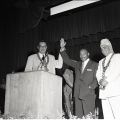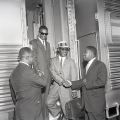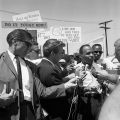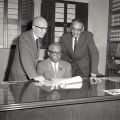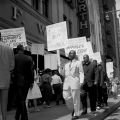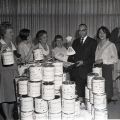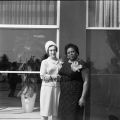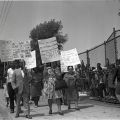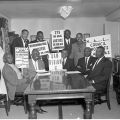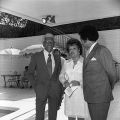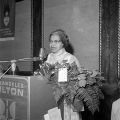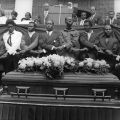The term civil rights is heavily associated with racial inequalities in the United States during the 1950s and 1960s. But not necessarily with Los Angeles. There is great geographical distance between the South and Los Angeles, but in the past, attitudes towards race in both regions were not always that different. 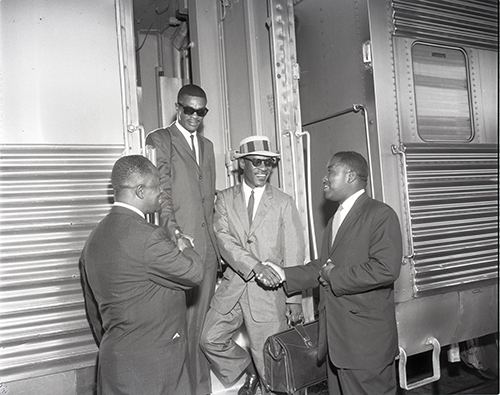 In Black communities on the West Coast during the 1960s there was a growing battle for equality, especially during interactions with police. However, during this national crisis there was also a very positive relationship that existed between the two regions that is not mentioned or studied enough. While dealing with its own forms of racism in Los Angeles the African American community and their allies provided an immense amount of support to the civil rights movement in the South, which makes absolute sense considering that many of its Black citizens were participants of the Great Migration.
In Black communities on the West Coast during the 1960s there was a growing battle for equality, especially during interactions with police. However, during this national crisis there was also a very positive relationship that existed between the two regions that is not mentioned or studied enough. While dealing with its own forms of racism in Los Angeles the African American community and their allies provided an immense amount of support to the civil rights movement in the South, which makes absolute sense considering that many of its Black citizens were participants of the Great Migration.
If it were not for the photographic collection at the Tom & Ethel Bradley Center, evidence of Los Angeles’s support for the modern civil rights movement in the South may have quietly slipped into the past. The beginning of the civil rights movement is often associated with three events: Brown vs. Board of Education (1954), the killing of Emmett Till (1955), and the Montgomery Bus Boycott (1955). Dr. Martin Luther King Jr. is often acknowledged as the leader or figurehead of the civil rights movement, starting in 1955 as the leader of the Montgomery Bus Boycott and lasting until his assassination in 1968. The African American photographic collection in the Bradley Center documents this era in the works of three photographers: Charles Williams, Harry Adams, and Guy Crowder. There are several hundred images of/or related to Dr. King, his many visits to Southern California, and other freedom fighters involved in the struggle. Charles Williams begin photographing Dr. King in Los Angeles as early as 1956. And Guy Crowder documented Dr. King’s eulogy at Morehouse College in 1968. In between those years Harry Adams documented the legacy of Dr. King and the civil rights movement in Los Angeles.
Dr. King and the movement have been documented in iconic photographs by high-profile photographers such as Bob Adelman (March on Washington), Steve Schapiro (Selma), and Don Cravens (King arrest photo). All the above-mentioned photographers were white men. They had a certain amount of access not available to Black men in the South. White racist police could quickly turn nonviolent protests violent in the South. They would attack anyone in range of their batons and a Black man with a camera might not be spared.  There were even instances of white photographers being attacked by police. The Bradley Center photographers who documented civil rights activities in Los Angeles had their own special access. They were not just photographers chasing stories for a newspaper or magazine. They documented what was going on in their community at a time when the lives of Black people were of little interest to mainstream newspapers.
There were even instances of white photographers being attacked by police. The Bradley Center photographers who documented civil rights activities in Los Angeles had their own special access. They were not just photographers chasing stories for a newspaper or magazine. They documented what was going on in their community at a time when the lives of Black people were of little interest to mainstream newspapers.
The photographers of Black Los Angeles contributions to the civil rights movement is of great historical significance. They not only document nationally and internationally recognized participants of the movement who visited LA but also local leaders who supported the South and broke down racial barriers in Los Angeles. Some of these Black photographers may or may not have had hopes for full-time employment in mainstream organizations. But unknown to them at the time working as independent photographers proved to be a blessing for the generations that follow them. Today students, faculty, scholars, and the community all have access to Black Los Angeles from the 1940s-2000s thanks to these photographers.
If you are interested in learning more about Los Angeles's connection to the Civil Rights Movement and Martin Luther King Jr. check out CSUN’s own Dr. Karin Stanford’s StoryMap: The Enduring Spirit of Martin Luther King Jr. in Los Angeles.



